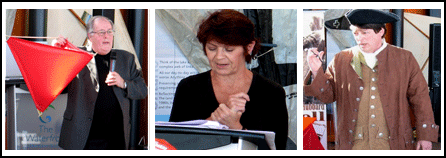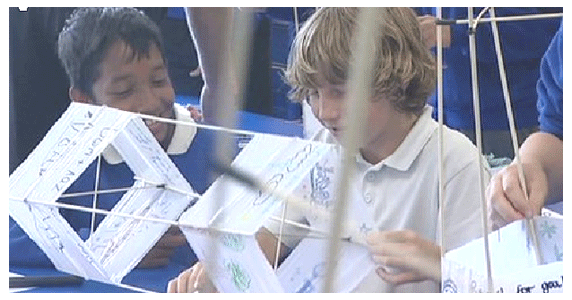Bristol Boxkite Airplane honoured on 100th Anniversary of Its First Flight
 England will celebrate the 100th Anniversary of a famous early aircraft at the upcoming Bristol International Kite Festival at the end of July, 2010. Part of the celebration features a launch of one hundred small, replica box kites constructed by students in Bristol area schools.
England will celebrate the 100th Anniversary of a famous early aircraft at the upcoming Bristol International Kite Festival at the end of July, 2010. Part of the celebration features a launch of one hundred small, replica box kites constructed by students in Bristol area schools.
The story of the students building kites and some information on the celebrated aircraft, the Bristol Box Kite, is featured in a BBC story entitled “Replica Boxkites celebrate aviation history with ascent”.
The Bristol Box Kite (the actual name of the early English airplane) flew for the first time on July 29, 1910 in Bristol, England.
Based on a successful design by Henri Farman, a French aviation pioneer, the Bristol Box Kite airplane was the first production airplane in the world with 76 units built by the Colonial Airplane Company in Bristol before a major design upgrade. The design was so similar to the original Farman airplane that Farman threatened legal action. Although no documents attest to this, it is rumoured that the manufacturer paid a license fee for each plane produced to Farman.
Sixty of the 76 production units were produced for the British War Ministry while the remaining twelve units went to the armed forces of Australia, Bulgaria, Russia, South Africa, and Spain. In spite of their fragile appearance, so typical of early aircraft, small numbers of the Bristol Box Kite remained in service with the England’s RAF as two-seat training aircraft during the early part of WWI.
The airplane is very famous and was featured in the 1965 movie “Those Magnificent Men in Their Flying Machines”. A successful flying replica built for the movie by 20th Century Fox was later sold to the British Aircraft Corporation at Filton, Bristol, England. The corporation presented the plane to Bristol's City Museum & Art Gallery in 1965 where it has been on display ever since.
The fact that this airplane was created and flown seven years after the flight of the Wright Flyer and two years later than the Aerial Experiment Association’s five pioneering aerodromes: the Cygnet (giant tetrahedral kite), the Red Wing, the White Wing, the June Bug, and the Silver Dart attests to the slow, measured progress in the development of early aircraft.
Steps in getting people successfully and safely into the air were very slow in the early stages. The principles of flight had been discovered and detailed by Sir George Cayley in 1799. Often named as the first person to understand the underlying principles and forces of flight, Cayley built a pioneering model glider in 1804 that successfully demonstrated that a device could be constructed to master the four aerodynamic forces of flight—weight, lift, drag, and thrust. Cayley’s glider used “push” as the source of thrust since no light weight power sources that could propel a structure aloft carrying a person were available until the early 1900’s. Once light weight engines were developed and supporting fuselage and wing structures were advanced enough, the Wrights, the AEA, and French and Brazilian aviation pioneers began building actual powered airplanes.
It is great to see the young students building box kites to fly at the Bristol International Kite Festival later this month. This is a great way to draw another generation of kiters into the wonder of tethered flight. Another 100th anniversary milestone of flight that links back to kites!
Webb Taylor - Small Kites Elevated to New Heights
Webb Taylor of Portsmouth Virginia is an accomplished kite maker of small kites that are really creative and interesting.
Coming from a background in aeronautics, the retired Mr. Taylor took up the making of small kites as a hobby. Webb has crafted some terrific small kites as he progresses in skill with this type of kite making.
Webb's work with kites and photos of his kites are found in a HamptonRoads.com on-line newspaper article by Cindy Clayton published in The Virginian-Pilot on July 11, 2010. The article is entitled "Hooked on Kite Making". The excellent photos that accoompany the article are by Steve Early of The Virginian-Pilot.
I found the article to be interesting for several reasons:
- Webb's kite designs are truly high quality small kites.
- Good photos of some of the steps that Webb uses to fashion his kites (these photos could be a guide to anyone wanting to get started in this type of kite making).
- A description of the type of bamboo that he uses for the framing materials (Webb splits ordinary bamboo food skewers to get the thin bendable strips of bamboo necessary for this type of kite construction).
- The article is more in depth than most standard newspaper articles about kites.
Journalist Cindy Clayton has done a great job in covering this story and showing the fine craftsmanship of Webb Taylor.
Perhaps this article about Webb Taylor's kite making will encourage you to start some kite making on a smaller scale.
For Additional Reading:
One of the finest miniature kite makers is Glenn Davison, a New England kite artist of world renown from Massachusetts. Glenn's web site, miniaturekitingusa.com, includes galleries of his amazing kites, plans and building tips to get you started or raise your skill with this fascinating aspect of kite building.
Effects of the Kite Flying Ban Imposed on Pakistan's Basant Festival in 2005
There has been much discussion about the effects of the kite flying ban imposed in 2005 in Pakistan to curtail the sale and flying of kites for the spring Basant festival.
The ban was supposedly implemented to reduce the number of fatalities and the damage caused by thousands of kites flown during the Basant festival. There can be no doubt that the glass and chemical coated string did cause a good deal of damage and injury to some citizens and birds. When taut, the coated kite string can cut flesh and has been documented to be the cause of serious injury and even death each year.
In addition, some segments of the population saw the kites and kite flying aspects of Basant as too secular and against more traditional religious beliefs and customs.
So, in 2005 the Pakistan government passed a law banning the sale of the kites and kite line during the festival. This severly hampered the livelihood of kite makers and vendors. In addition, the ban also affected the sights and flavour of the Basant festival. Formerly the skies were filled with colourful battling kites by the hundreds and thousands, Today, only a few daring kiters send their kites soaring to the skies.
It is feared by some that the rich tradition of Pakistani kite making and flying will be lost over the coming years.
In March of 2010 the English language branch of the AlJazeera Network examined the current kite flying situation during Basant in Pakistan.
The history of kites and kite flying in Pakistan has a long and rich history. One can only hope that the skills of kite making and kite flying will not be lost over the coming years.
Note:
For additional background on the kites of Pakistan and their role in the festival of Basant, see my earlier article entitled: Kites in Pakistan: the kites of Basant in Lahore, Pakistan.
First Kite History Symposium Held In Burlington, Ontario.
On February 6, 2010 a group of interested kite enthusiasts gathered at Discovery Landing, on the Lake Ontario shoreline in Burlington, Ontario, to immerse themselves in day dedicated to the exploration of kite history. This was the first ever Kite History Symposium held in eastern North America.
The event was sponsored and organized by the Canadian Kite Museum under the direction of George Paisiovich, Museum Founder and Director.

The program for the day featured:
- a two hour informal morning gathering of the registered kiters examining historic kite artefacts, photographs and print materials;
- a welcome to the Kite History Symposium by George Paisiovich in which he outlined his goal of providing a periodic forum for the discussion and advancement of knowledge of kite history;
- a one hour presentation by Bob White of Port Colborne, ON about the kites of Dr. Alexander Graham Bell. This preliminary report on research in progress brought participants up to date on the work being done to carefully detail the step by step progress made by Dr. Bell on his path to understand the principles of flight and to get a person into the air.
- a presentation by Meg Albers of Buffalo, NY on the kite exploits of Homan Walsh whose kite helped to build a bridge across the Niagara River in 1848. Meg also revealed some documents she has received that prove the use of kites during the American Civil War. She continues her research into kites in the Civil War era.
- a two hour presentation by Thom Shanken of Waterloo, NY about his research into the world's oldest kite currently located at the Drachen Foundation in Seattle, WA. Thom Shanken, an expert in 16th century kites, was invited by the Drachen Foundation to examine the kite and make a detailed analysis of this amazing historical find. Thom presented slides and an interesting description of his work with the kite. Following this, a replica of the kite was constructed by the participants. The replica is detailed in the slide show below. The replica is now part of the collection of the Canadian Kite History Museum.

At the end of the day, the participants gathered for an informal evening meal and conversation about the events of the day.
A terrific slide show of the Kite History Symposium was prepared by Ted Shaw of the Great Lakes Kitefliers in Western New York state. My appreciation is extended to Ted for allowing me to share his photos of the event here.
The next Kite History Symposium sponsored by the Canadian Kite Museum will be held in October 2010. As details are announced I will provide a link to the information here.
Appreciation is extended to George Paisiovich for his outstanding work in support of the preservation of kite history and efforts to foster and disseminate knowledge of current kite history research work that is underway.
Excellent "Make A Kite" Video from the Hila Outdoor Centre
Carol and Wayne Campbell are owners of the Hila Outdoor Centre on the Ottawa River in Ontario, Canada. This twelve acre facility recently celebrated 25 years of science and nature education. The Hila Outdoor Centre has an excellent reputation for strong educational programs in the sciences.
One of the most innovative aspects of the Hila Centre's work is the outreach and followup program that Carol and Wayne employ using videos to support teachers, parents and students in learning.
Their video on making a kite is one of the best, short educational videos to assist teachers with some of the principles of kite flight. In addition, the step by step procedure for making a 'sled kite' is a sure way to achieve success with a classroom program in kite building. The kite that the Hila Outdoor Centre video features is the 'sled' kite. It is a simple to make, yet sure to fly kite that is excellent for educational purposes.
Carol and Wayne's work was featured in a recent technology in education blog on the prestigious Edutopia website.
If you need additional information about using kites in the classroom, please contact me.





